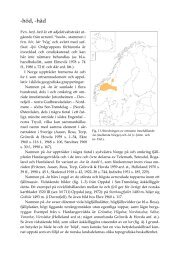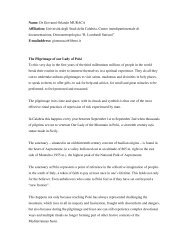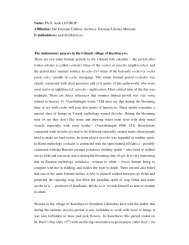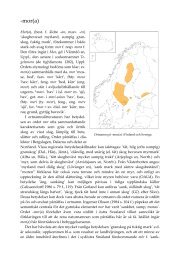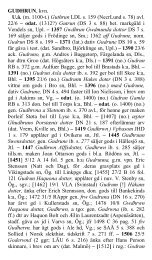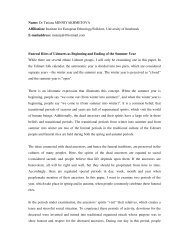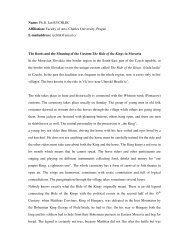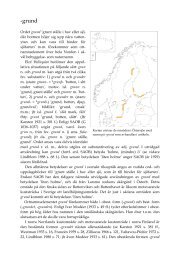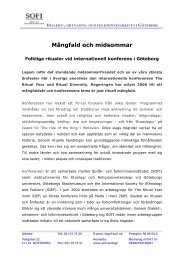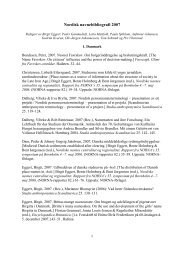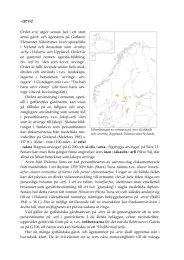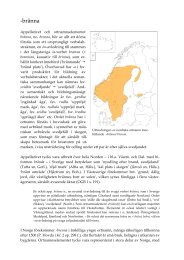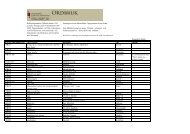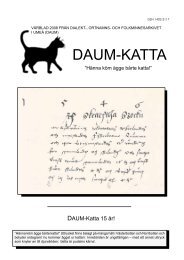NORNA-RAPPORTER 88 Binamn. Uppkomst, bildning, terminologi ...
NORNA-RAPPORTER 88 Binamn. Uppkomst, bildning, terminologi ...
NORNA-RAPPORTER 88 Binamn. Uppkomst, bildning, terminologi ...
Create successful ePaper yourself
Turn your PDF publications into a flip-book with our unique Google optimized e-Paper software.
34 Bertie Neethling<br />
Non-derivative types (external)<br />
Many bynames are not formed through any derivational pattern via the first<br />
name, but come into being based on particular features associated with the<br />
name carrier, such as physical characteristics, personality traits, events in the<br />
life of the name carrier, associations with sport, music (types and artists), etc.<br />
This is clearly the area where bynames have the potential not to be embraced<br />
by the name carrier as would normally be the case with the derivative types. If<br />
a prominent physical feature which is not generally considered to be a flattering<br />
and admired one is used as the origin for a byname (perhaps ‘nickname’ is more<br />
apt), then it stands to reason that the name carrier either has to accept the byname<br />
with good humour or may desperately try to discourage its usage. The latter<br />
is often easier said than done. Such ‘negative’ bynames have a tendency to<br />
persist, whether name carriers like them or not. Despite the existence of such<br />
negative bynames in the data, it is, of course, very possible that respondents<br />
may have elected not to mention these bynames. There was no control over this<br />
possibility. Felecan (2009) suggested earlier that name carriers may be oblivious<br />
about these not so flattering bynames, i.e. they are only used to refer to<br />
an individual when s/he is not present. That is possible, but seeing that respondents<br />
themselves reported on their bynames, suggests that they know them and<br />
the people who use them.<br />
1. Physical characteristic<br />
This is probably a universal category. Body size (small, thin, fat) is popular, as<br />
well as complexion features. Some may have been acquired in childhood times<br />
or during early schooling, and may no longer be applicable, but persist in<br />
usage. Examples:<br />
Sivuyile > Lhoza (thin like a cigarette)<br />
Nwabisa Bernice > Sjupa/Stokoloza (thin/bones ex Afrikaans (stok=‘stick’)<br />
Thembela > Tuta/Mshwela (not tall)<br />
Phatheka Cornelia > Noncondwana (thin)<br />
Thando > Roro (round little girl)<br />
Unathi > Hagwana (< ihagu ‘pig’ – cute like little white pig)<br />
Muammar > Fat Mo<br />
Peter Henry > Jules (< kilojoules), Bok uitgevreet (‘satiated buck’)<br />
Melody >Miss Piggy (fat when small)<br />
Marshay > Vettie (Afrikaans ‘fat’)<br />
Nwabisa Kanyiso > Cremora [a coffee creamer] (complexion)<br />
Yolanda > Cocoa (complexion)<br />
Vuyiswa > Notumato (< tomato ‘soft skin’)<br />
Nathan > Black Man<br />
Shanine > Whitey (irony: dark complexion)<br />
Orenthal Wilbur > Nigga O/Da Nigga (dark complexion)



